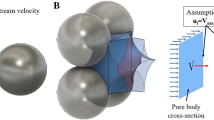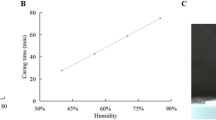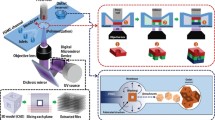Abstract
3D-printed porous microfluidics has been proposed to realize complex passive lab-on-chips. The performance of these devices depends on capillary flow design and control. To this end, a predictive multiscale model of capillary imbibition in porous channels obtained through powder-based 3D printing was developed. Pore-network modelling was used to obtain fluid flow characteristics of the printed material depending on the porous microstructure and hydrophilicity, coupled to the Richards equation. The latter was solved numerically to predict capillary flow in printed chips. Dynamic high-resolution microcomputed tomography (µCT) was employed for in situ verification of the capillary imbibition, which was found to be slower than theoretically expected. Channels with a larger cross-section demonstrated faster wicking, suggesting higher hydrophilicity. Multiscale simulations suggest that this phenomenon as well as the delayed imbibition initiation are caused by modifications of the porous channel surface during and after 3D printing.









Similar content being viewed by others
References
Achille C, Parra-cabrera C, Dochy R et al (2021) 3D Printing of monolithic capillarity-driven microfluidic devices for diagnostics. Adv Mater 2008712:1–7. https://doi.org/10.1002/adma.202008712
Alderete N, VillagránZaccardi Y, Snoeck D et al (2019) Capillary imbibition in mortars with natural pozzolan, limestone powder and slag evaluated through neutron radiography, electrical conductivity, and gravimetric analysis. Cem Concr Res 118:57–68. https://doi.org/10.1016/j.cemconres.2019.02.011
Ameloot R, Achille C (2018) 3D PRINTING OF POROUS LIQUID HANDLING DEVICE. 00
Blunt MJ, Scher H (1995) Pore-level modeling of wetting. Phys Rev E 52:6387–6403. https://doi.org/10.1103/PhysRevE.52.6387
Boodaghi M, Shamloo A (2020) A comparison of different geometrical elements to model fluid wicking in paper-based microfluidic devices. AIChE J. https://doi.org/10.1002/aic.16756
Brooks RH, Corey AT (1964) Hydraulic properties of porous materials. Hydraul Pap Color State University, Fort Collins
Chakraborty S (2010) Microfluidics and microfabrication. Springer, Boston
Cihan A, Tyner JS, Perfect E (2009) Predicting relative permeability from water retention: a direct approach based on fractal geometry. Water Resour Res 45:1–8. https://doi.org/10.1029/2008WR007038
Cihan A, Birkholzer J, Illangasekare TH, Zhou Q (2014) A modeling approach to represent hysteresis in capillary pressure-saturation relationship based on fluid connectivity in void space. Water Resour Res 50:119–131. https://doi.org/10.1002/2013WR014280
Cruz AP, Stiharu I, Dominguez A (2017) Two - dimensional model of imbibition into paper-based networks using Richards ’ equation. Microfluid Nanofluidics 21:1–12. https://doi.org/10.1007/s10404-017-1937-0
Cummins BM, Chinthapatla R, Ligler FS, Walker GM (2017) Time-dependent model for fluid flow in porous materials with multiple pore sizes. Anal Chem 89:4377–4381. https://doi.org/10.1021/acs.analchem.6b04717
Dal Dosso F, Kokalj T, Belotserkovsky J et al (2018) Self-powered infusion microfluidic pump for ex vivo drug delivery. Biomed Microdevices 20:1–11. https://doi.org/10.1007/s10544-018-0289-1
Dal Dosso F, Bondarenko Y, Kokalj T, Lammertyn J (2019) SIMPLE analytical model for smart microfluidic chip design. Sens Actuators A Phys 287:131–137. https://doi.org/10.1016/j.sna.2019.01.005
Doster F, Nordbotten JM, Celia MA (2013) Impact of capillary hysteresis and trapping on vertically integrated models for CO2 storage. Adv Water Resour 62:465–474. https://doi.org/10.1016/j.advwatres.2013.09.005
Elizalde E, Urteaga R, Berli CLA (2015) Rational design of capillary-driven flows for paper-based microfluidics. Lab Chip 15:2173–2180. https://doi.org/10.1039/c4lc01487a
Feldkamp LA, Davis LC, JWK Research (1984) Practical cone-beam algorithm. J Opt Soc Am A 1:612–619
Galindo-Rosales FJ (2017) Complex fluid-flows in microfluidics. Springer, Cham
Gong MM, Sinton D (2017) Turning the page: advancing paper-based microfluidics for broad diagnostic application. Chem Rev 117:8447–8480. https://doi.org/10.1021/acs.chemrev.7b00024
He Y, Wu Y, Fu JZ, Bin WuW (2015) Fabrication of paper-based microfluidic analysis devices: a review. RSC Adv 5:78109–78127. https://doi.org/10.1039/c5ra09188h
Hilpert M, Miller CT (2001) Pore-morphology-based simulation of drainage in totally wetting porous media. Adv Water Resour 24:243–255. https://doi.org/10.1016/S0309-1708(00)00056-7
Hong S, Kim W (2015) Dynamics of water imbibition through paper channels with wax boundaries. Microfluid Nanofluidics 19:845–853. https://doi.org/10.1007/s10404-015-1611-3
Joekar-Niasar V, Hassanizadeh SM (2012) Analysis of fundamentals of two-phase flow in porous media using dynamic pore-network models: a review. Crit Rev Environ Sci Technol 42:1895–1976. https://doi.org/10.1080/10643389.2011.574101
Johnson RS, Niedermeier W (1968) Viscosity of biological fluids. A review article. Ala J Med Sci 5:428–433
Jones G, Fornwalt HJ (1936) The viscosity of aqueous solutions of electrolytes as a function of the concentration. III. Cesium iodide and potassium permanganate. J Am Chem Soc 58:619–625. https://doi.org/10.1021/ja01295a026
Kim SJ, Paczesny S, Takayama S, Kurabayashi K (2013) Preprogrammed capillarity to passively control system-level sequential and parallel microfluidic flows. Lab Chip 13:2091–2098. https://doi.org/10.1039/c3lc50187f
Kuang X, Jiao JJ (2011) A new model for predicting relative nonwetting phase permeability from soil water retention curves. Water Resour Res. https://doi.org/10.1029/2011WR010728
Lewis GG, Ditucci MJ, Phillips ST (2012) Quantifying analytes in paper-based microfluidic devices without using external electronic readers **. Angew Chemie Int Ed. https://doi.org/10.1002/anie.201207239
Li X, Ballerini DR, Shen W (2012) A perspective on paper-based microfluidics: current status and future trends. Biomicrofluidics. https://doi.org/10.1063/1.3687398
Liana DD, Raguse B, Justin Gooding J, Chow E (2012) Recent Advances in Paper-Based Sensors. Sensors (Switzerland) 12:11505–11526. https://doi.org/10.3390/s120911505
Lutz B, Liang T, Fu E et al (2013) Dissolvable fluidic time delays for programming multi-step assays in instrument-free paper diagnostics. Lab Chip 13:2840. https://doi.org/10.1039/c3lc50178g
Ma Y, Cao X, Feng X et al (2007) Fabrication of super-hydrophobic film from PMMA with intrinsic water contact angle below 90°. Polymer (Guildf) 48:7455–7460. https://doi.org/10.1016/j.polymer.2007.10.038
Novák V, Hlaváčiková H (2019) Soil–water retention curve. In: Novák V, Hlaváčiková H (eds) Theory and applications of transport in porous media. Springer International Publishing, Cham, pp 77–96
Oren P-E, Bakke S, Arntzen OJ (1998) Extending predictive capabilities to network models. SPE J 3:324–336. https://doi.org/10.2118/52052-PA
Parra-Cabrera C, Achille C, Kuhn S, Ameloot R (2018) 3D printing in chemical engineering and catalytic technology: structured catalysts, mixers and reactors. Chem Soc Rev 47:209–230. https://doi.org/10.1039/C7CS00631D
Piovesan A, Achille C, Ameloot R et al (2019) Pore network model for permeability characterization of three-dimensionally-printed porous materials for passive microfluidics. Phys Rev E. https://doi.org/10.1103/PhysRevE.99.033107
Piovesan A, Van De Looverbosch T, Verboven P et al (2020) 4D synchrotron microtomography and pore-network. Lab Chip 20:2403–2411. https://doi.org/10.1039/c2lc41193h
Rabbani A, Jamshidi S, Salehi S (2014) An automated simple algorithm for realistic pore network extraction from micro-tomography images. J Pet Sci Eng 123:164–171. https://doi.org/10.1016/j.petrol.2014.08.020
Rath D, Toley BJ (2021) Modeling-guided design of paper microfluidic networks: a case study of sequential fluid delivery. ACS Sens 6:91–99. https://doi.org/10.1021/acssensors.0c01840
Rath D, Sathishkumar N, Toley BJ (2018) Experimental measurement of parameters governing flow rates and partial saturation in paper-based microfluidic devices. Langmuir 34:8758–8766. https://doi.org/10.1021/acs.langmuir.8b01345
Richards LA (1931) Capillary conduction of liquids through porous mediums. J Appl Phys 1:318–333. https://doi.org/10.1063/1.1745010
Sackmann EK, Fulton AL, Beebe DJ (2014) The present and future role of microfluidics in biomedical research. Nature 507:181–189. https://doi.org/10.1038/nature13118
Safavieh R, Juncker D (2013) Capillarics: pre-programmed, self-powered microfluidic circuits built from capillary elements. Lab Chip 13:4180–4189. https://doi.org/10.1039/c3lc50691f
Soille P (1999) Morphological image analysis: principles and applications. Springer, Berlin
Tarantino A, Mancuso C (2000) Experimental evidence and theoretical approaches in unsaturated soils. Int Work Unsatur Soils Exp Evid Theor Approach
Tranter TG, Gostick JT, Burns AD, Gale WF (2018) Capillary hysteresis in neutrally wettable fibrous media: a pore network study of a fuel cell electrode. Transp Porous Media 121:597–620. https://doi.org/10.1007/s11242-017-0973-2
van Genuchten MT (1980) A closed-form equation for predicting the hydraulic conductivity of unsaturated soils. Soil Sci Soc Am J 44:892–898. https://doi.org/10.2136/sssaj1980.03615995004400050002x
Wang X, Sheng JJ (2018) Spontaneous imbibition analysis in shale reservoirs based on pore network modeling. J Pet Sci Eng 169:663–672. https://doi.org/10.1016/j.petrol.2018.06.028
Washburn EW (1921) The dynamics of capillary flow. Phys Rev 17:273–283. https://doi.org/10.1103/PhysRev.17.273
Wassar F, Gandolfi C, Rienzner M et al (2016) Predicted and measured soil retention curve parameters in Lombardy region north of Italy. Int Soil Water Conserv Res 4:207–214. https://doi.org/10.1016/j.iswcr.2016.05.005
Zaccardi YV, Alderete N, De Belie N (2018) Lucas–Washburn vs Richards equation for the modelling of water absorption in cementitious materials. MATEC Web Conf. https://doi.org/10.1051/matecconf/201819902019
Acknowledgements
The FWO large infrastructure I013518N project is acknowledged for their financial support and the KU Leuven XCT Core facility is acknowledged for the 3D image acquisition and quantitative post-processing tools (https://xct.kuleuven.be/).
Funding
This research was funded by the Research Foundation Flanders—FWO Vlaanderen (SB Scholarship No. 1S44318N). R.A., B.N., P.V., and C.P.-C. additionally acknowledge the financial support from KU Leuven (project C24/16/022) and the Research Foundation Flanders—FWO Vlaanderen (Projects no. 1516717N, 1512320N, and G084818N). C.P-C. acknowledges the Research Foundation—Flanders (FWO) for a postdoctoral fellowship (12U8718N) and the research Grant 1512320N.
Author information
Authors and Affiliations
Contributions
Experimental data were collected by AP and TA with help and supervision of JS and RD. AP with the help of RN, TA and BD developed and optimized the multiscale model, supervised by PV and BN. CA, RD and CP-C provided the 3D printed platforms. AP drafted the manuscript, all the other authors provided feedback and revisions.
Corresponding author
Ethics declarations
Conflict of interest
The authors declare no conflict of interest, moreover, the authors declare that the funders had no role in the design of the study; in the collection, analyses, or interpretation of data; in the writing of the manuscript, or in the decision to publish the results.
Additional information
Publisher's Note
Springer Nature remains neutral with regard to jurisdictional claims in published maps and institutional affiliations.
Supplementary Information
Below is the link to the electronic supplementary material.
Rights and permissions
About this article
Cite this article
Piovesan, A., Nicasy, R., Arens, T. et al. Multiscale modelling of capillary imbibition in 3D-printed porous microfluidic channels. Microfluid Nanofluid 26, 21 (2022). https://doi.org/10.1007/s10404-022-02528-0
Received:
Accepted:
Published:
DOI: https://doi.org/10.1007/s10404-022-02528-0




